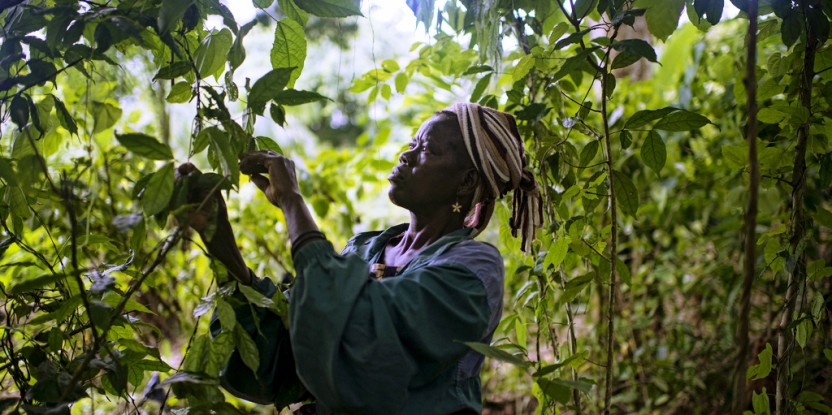
Two hundred million hectares, and sixty million people.
That’s the size and feeding power of the forests of the Congo Basin — the second largest expanse of tropical forest in the world.
Yet this large resource area has often been a flash point for conflict, frequently because of poor forest management and illegal activity.
The problem is particularly serious in Central Africa’s concessions, where industrial timber exploitation has often been considered to have negative impacts on agriculture, hunting and small-scale logging.
Can allowing a forest concession to be used in multiple ways reduce or even resolve conflict and allow people to use the forest legally and peacefully?
Providing forest users with clear incentives to work together could reduce conflict and improve the management of Central Africa’s timber concessions, according to a new study.
Multiple-use forest management — using the forest in several ways (wood, gardens, bushmeat, wild food, environmental uses, tourism) — is seen by advocates as a more equitable and balanced use of resources among multiple users.
We have to look at real conflicts among stakeholders and forget the debate about international public goods, such as protecting biodiversity or storing carbon.
This form of management has been integrated into the forestry laws of Congo Basin countries since the mid-1990s, mainly through the management of timber concessions, but, according to the study, its application has had limited success.
There have been two main obstacles: not enough emphasis on local stakeholders, and a lack of financial incentives for different groups to take part.
CONFLICT, DEBATE, FORESTS
Guillaume Lescuyer, a scientist seconded to the Center for International Forestry Research (CIFOR) from the French Agricultural Research Centre for International Development (CIRAD) and one of the report’s authors, says both issues need addressing.
“We have to look at the real conflicts among stakeholders and forget a little bit about the debate about international public goods, such as protecting biodiversity or storing carbon,” he says.
“The other issue is we have to deal with financial costs and benefits if we want to convince stakeholders to change their behaviors,” he says.
As part of the study, the authors assessed six timber concessions in Cameroon, Gabon and the Democratic Republic of Congo. Around each concession, five to seven villages were studied and 10 to 20 percent of households were sampled over a year — 308 households overall.
Researchers also interviewed key stakeholders who were not located in the sample area, namely logging companies and government representatives.
Agriculture, chainsaw logging and hunting were identified as the main sources of conflict with industrial timber exploitation. Once these were pinpointed, the researchers looked at ways to resolve the disputes and estimated the costs of resolution. The last step was crucial, as it gave stakeholders a clear idea of the costs and benefits associated with the implementation of a multiple-use scheme.
“We have to provide monetary costs and benefits,” Lescuyer says. “One of the issues is that there is no effective financial incentive to do multiple-use forest management.”
REALISTIC COMPROMISES
By providing a clear financial evaluation — in this case, over a 15-year period — stakeholders could accurately assess the cost of compromise against their incomes.
In the six timber concessions studied, all stakeholders put forward “realistic compromises” to implement multiple-use forest management in timber concessions, and possible compromises emerged.
There is no effective financial incentive to do multiple-use forest management.
Logging companies would finance local development in activities such as agroforestry or breeding. This would cost the companies money, Lescuyer says, but the trade-off would be a tax reduction as a means of compensation.
And because local people would benefit from these new activities, they would be required to reduce some illegal activities in the logging concessions.
“The state would accept reducing forestry taxes for the logging companies, but they can expect some new socioeconomic development because there will be new activities at the local level,” Lescuyer says.
The authors say that the fact that local communities, logging companies and the government could come to a consensus raises questions about the existing model for timber concessions in Central Africa.
In three of the case study areas, the promotion of multiple-use forest management needed input from outside the concessions, such as support for agroforestry and plantation initiatives.
This shows the importance of taking into account external factors that can influence change in concessions, such as commodity prices or the improvement of roads.
Lescuyer says the lessons of the study are applicable to timber concessions across the Congo Basin, and he hopes governments and logging companies take note.
“Ultimately, concessions shouldn’t be dedicated solely to timber exploitation,” says Lescuyer, “They should be seen as part of a broader landscape for sustainable development.”
This research forms part of the CGIAR Research Program on Forests, Trees and Agroforestry.
We want you to share Forests News content, which is licensed under Creative Commons Attribution-NonCommercial-ShareAlike 4.0 International (CC BY-NC-SA 4.0). This means you are free to redistribute our material for non-commercial purposes. All we ask is that you give Forests News appropriate credit and link to the original Forests News content, indicate if changes were made, and distribute your contributions under the same Creative Commons license. You must notify Forests News if you repost, reprint or reuse our materials by contacting forestsnews@cifor-icraf.org.